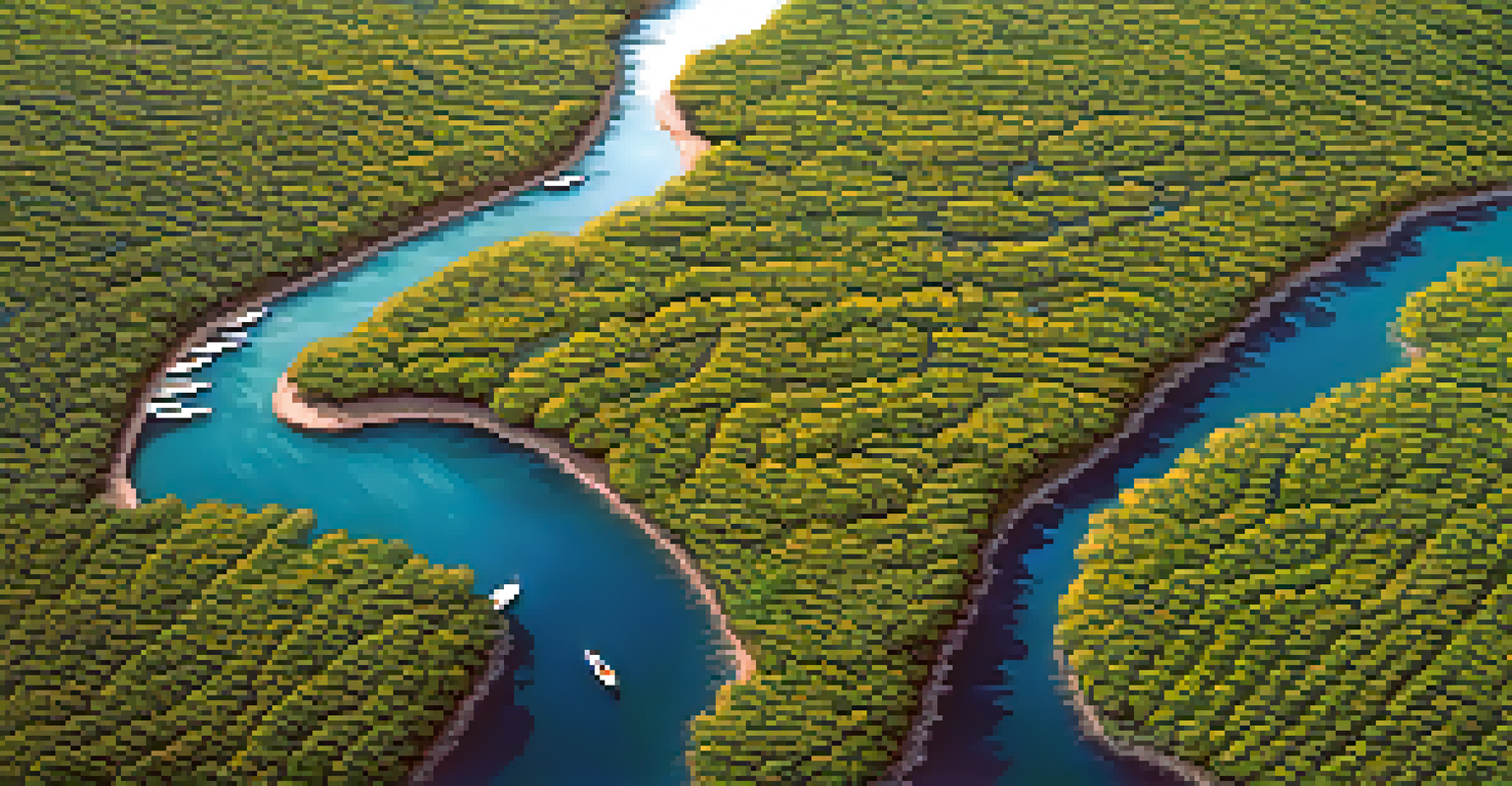The Importance of Mangroves in Protecting Coastal Marine Life

What Are Mangroves and Where Do They Grow?
Mangroves are unique trees that thrive in coastal intertidal zones, where saltwater meets freshwater. These resilient plants have adapted to harsh conditions, including strong tides and salty soils, making them critical to coastal ecosystems. You can find mangroves in tropical and subtropical regions around the world, forming dense forests that serve as vital habitats for countless marine species.
Mangroves are a critical part of coastal ecosystems, protecting shorelines and supporting biodiversity.
These coastal trees have specialized roots that not only stabilize the shoreline but also provide a nursery for juvenile fish and other marine life. In fact, many commercially important fish species, like snapper and grouper, begin their lives in the protective embrace of mangrove roots. This unique environment supports a diverse range of organisms, from crabs to migratory birds, each playing an essential role in the ecosystem.
In addition to their biological importance, mangroves also offer significant economic value. They support local fisheries, which many communities rely on for their livelihoods. This symbiotic relationship between mangroves and marine life showcases the importance of preserving these vital ecosystems for both nature and human well-being.
Mangroves as Natural Barriers Against Storm Surges
One of the most compelling benefits of mangroves is their ability to act as natural barriers against storm surges and coastal erosion. When hurricanes or tropical storms hit, the dense root systems of mangroves help to absorb and dissipate wave energy, reducing the impact on coastal communities. In many places, these trees can mean the difference between devastation and survival during extreme weather events.

The effectiveness of mangroves in mitigating storm damage has been demonstrated in various regions, where areas with healthy mangrove forests experienced less flooding and property damage compared to those without. This characteristic not only protects human habitats but also helps sustain marine ecosystems by maintaining water quality and preventing sedimentation from land runoff.
Mangroves: Nature's Coastal Protectors
Mangroves act as natural barriers that absorb wave energy, reducing the impact of storm surges and protecting coastal communities.
As climate change continues to raise sea levels and increase the frequency of severe storms, the preservation and restoration of mangroves become even more critical. By investing in these natural defenses, communities can enhance their resilience against the ever-growing threats posed by climate change.
The Role of Mangroves in Carbon Sequestration
Mangroves are often referred to as 'blue carbon' ecosystems because of their remarkable ability to sequester carbon dioxide from the atmosphere. They capture and store carbon in both their biomass and the soil, making them one of the most efficient carbon sinks on the planet. This process is crucial in mitigating climate change, as it helps to offset greenhouse gas emissions.
The protection of mangroves is essential for the health of our oceans and the communities that depend on them.
Studies have shown that mangrove forests can store up to four times more carbon per hectare than tropical rainforests. This means that protecting and restoring mangroves not only benefits marine life but also plays a pivotal role in global efforts to combat climate change. Each mangrove tree contributes to a healthier planet, showcasing the interconnectedness of ecosystems.
Furthermore, as coastal communities face the repercussions of climate change, the role of mangroves in carbon sequestration can lead to financial benefits through carbon credit programs. These initiatives can provide funding for conservation projects, ensuring that mangroves are preserved for future generations while also supporting local economies.
Biodiversity Support in Mangrove Ecosystems
Mangroves are biodiversity hotspots, supporting a wide array of species that rely on these unique habitats for survival. The intricate root systems provide shelter and breeding grounds for various marine organisms, including fish, shellfish, and crustaceans. This rich biodiversity is essential for maintaining healthy marine ecosystems and supporting sustainable fisheries.
In addition to marine life, mangroves also provide habitat for numerous terrestrial species, including birds, reptiles, and mammals. This interconnected web of life highlights the importance of protecting mangroves, as the loss of these ecosystems can have cascading effects on both land and sea. The health of mangrove forests directly influences the abundance and diversity of species within these environments.
Vital Ecosystems for Biodiversity
Mangroves support a diverse range of species, providing essential habitats for both marine and terrestrial life.
Efforts to conserve mangroves not only benefit the species that inhabit them but also contribute to the overall health of our planet. By safeguarding these natural habitats, we ensure the survival of countless organisms and preserve the delicate balance of coastal ecosystems.
Threats to Mangrove Ecosystems
Despite their ecological significance, mangroves face numerous threats that jeopardize their survival. Coastal development, pollution, and climate change are among the primary factors leading to the degradation of these vital ecosystems. Urbanization often results in the clearing of mangroves for infrastructure, which can disrupt the delicate balance of marine habitats.
Additionally, rising sea levels and increased salinity due to climate change pose significant challenges for mangrove survival. As coastal areas become more vulnerable, the health of mangroves is compromised, leading to a decline in the numerous benefits they provide. This creates a vicious cycle, where the loss of mangroves exacerbates coastal erosion and impacts marine life further.
Conservation efforts are critical in addressing these threats, and they require collaboration between governments, local communities, and conservation organizations. By raising awareness and promoting sustainable practices, we can work together to protect and restore mangrove ecosystems for future generations.
Conservation Efforts for Mangrove Restoration
Recognizing the critical role of mangroves, many organizations and communities are actively engaged in conservation and restoration efforts. These initiatives focus on replanting mangroves in degraded areas, protecting existing forests, and raising awareness about their importance. Such actions not only restore habitats but also enhance the resilience of coastal communities to climate change.
Community involvement is key to successful mangrove restoration projects. Local people often have valuable knowledge about their ecosystems and can play an essential role in maintaining and protecting mangroves. By empowering communities to take the lead, we can ensure that conservation efforts are sustainable and beneficial to both nature and the people who rely on these resources.
Carbon Sequestration Champions
Mangroves are efficient carbon sinks, capturing and storing significant amounts of carbon dioxide, which helps mitigate climate change.
Furthermore, innovative approaches such as ecotourism and sustainable fishing practices can provide economic incentives for mangrove conservation. By highlighting the value of healthy mangrove ecosystems, we can foster a greater appreciation for these vital habitats and encourage their protection.
Conclusion: The Future of Mangroves and Coastal Marine Life
The importance of mangroves in protecting coastal marine life cannot be overstated. They provide essential habitat, act as natural barriers against storms, and play a crucial role in carbon sequestration. As we face increasing environmental challenges, preserving these ecosystems is more critical than ever for the health of our planet and the well-being of coastal communities.
By understanding the interconnectedness of mangroves, marine life, and human communities, we can foster a sense of responsibility towards their protection. Each small action, whether it’s supporting conservation efforts or spreading awareness, can contribute to a brighter future for mangroves and the diverse species that depend on them.

Ultimately, the future of mangroves lies in our hands. Through collective action, we can ensure that these vital ecosystems continue to thrive, supporting both marine life and the communities that cherish them for generations to come.